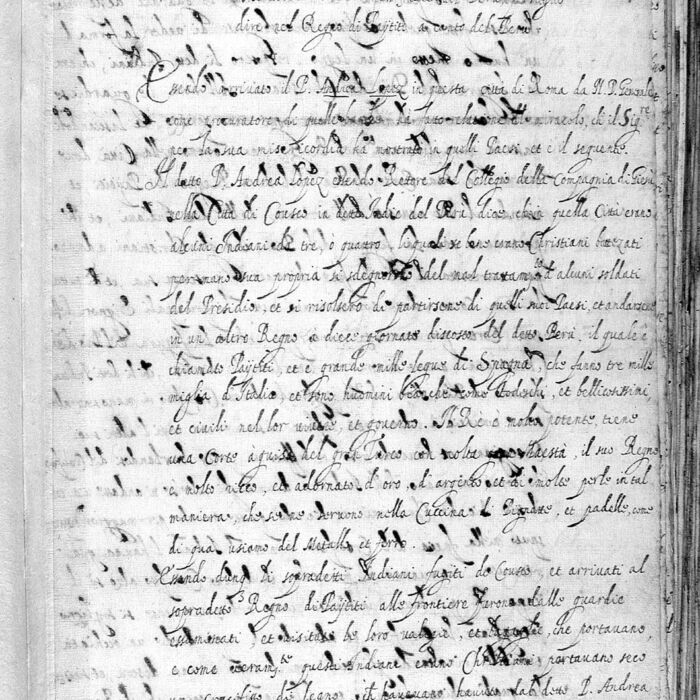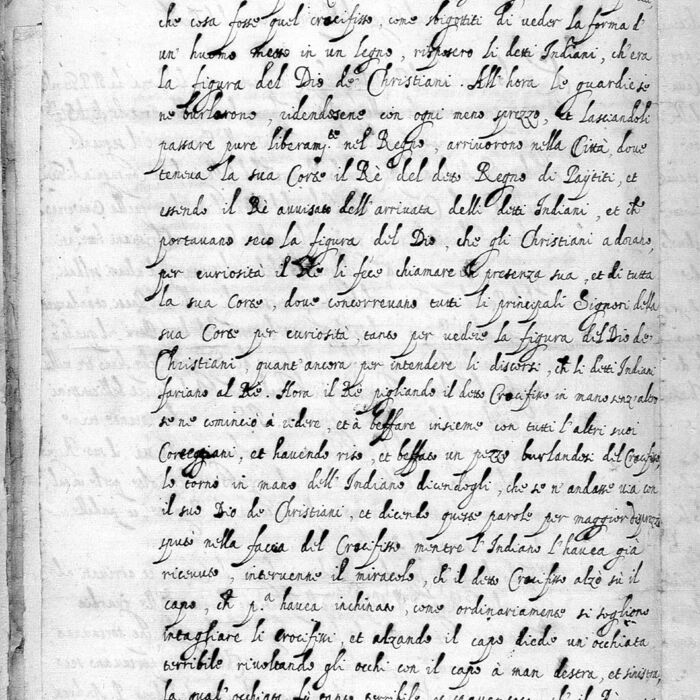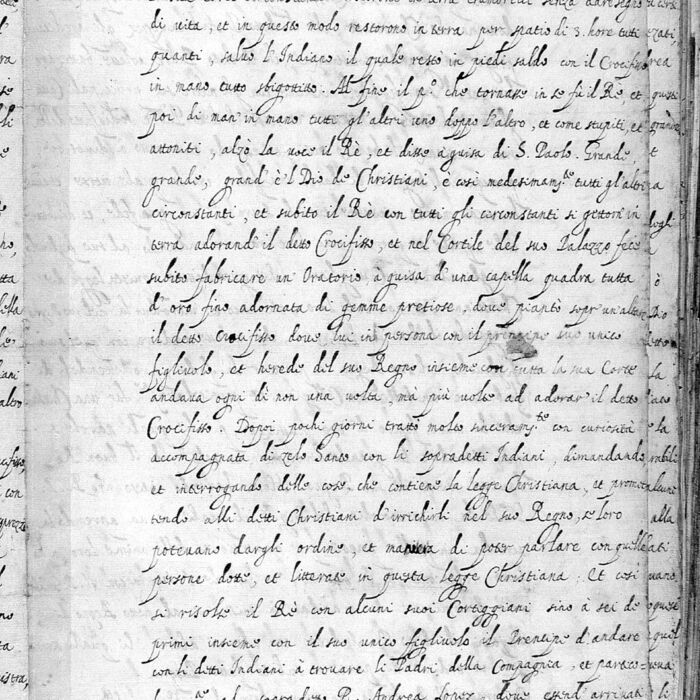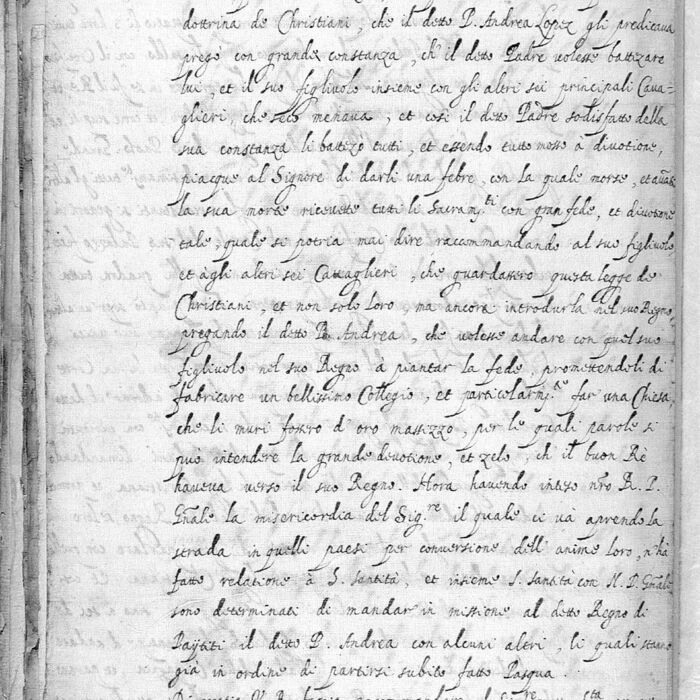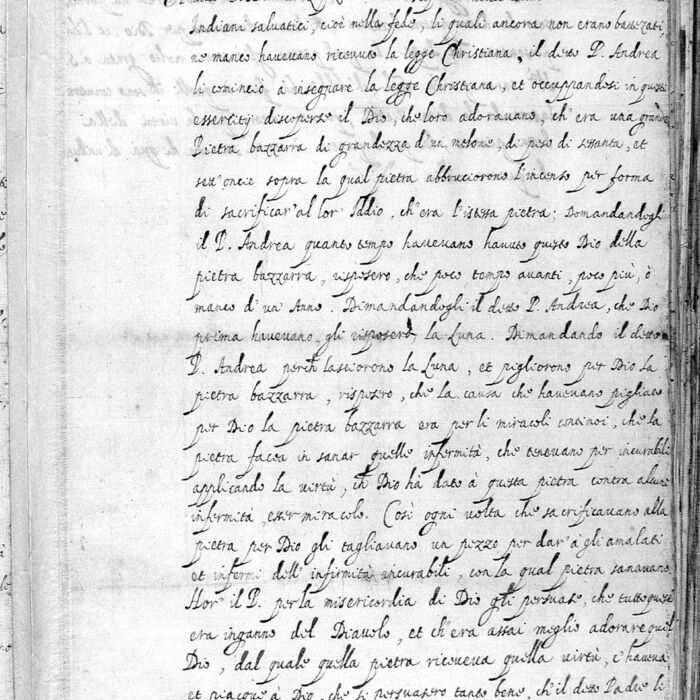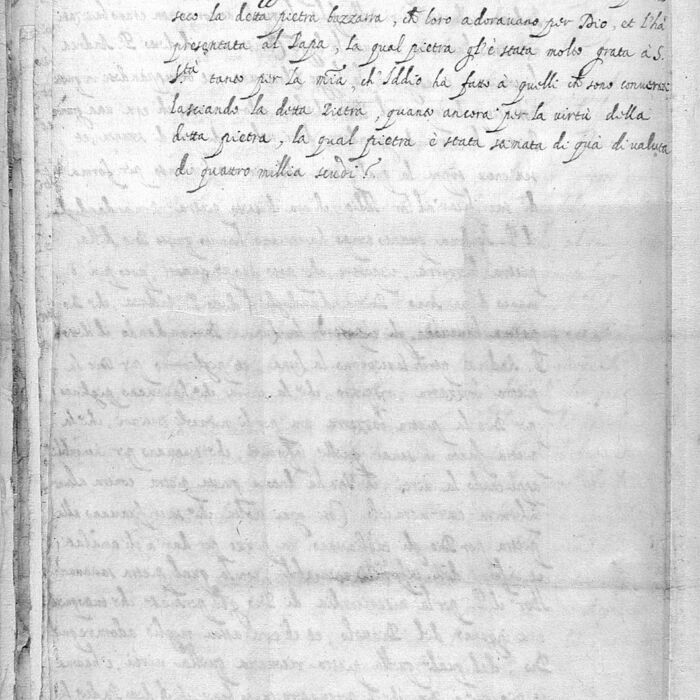This report, dating from 1567-1625, was discovered in the archives of the Society of Jesus (the Jesuit order) by an Italian historian and archaeologist Mario Polia, who published it in 2002 in the Italian magazine “Archeo” [1].

The author of the report and the addressee are unknown, but there is no doubt to historians about existence of the Father Andrea Lopez, which will be told. Moreover, the rank of the involved historical figures allows us to say that it is not just about rumours, but verified information. However, the papal order on evangelisation of Paititi residents, which could confirm the stated event, has not yet been found.
To get access to this document [2] we referred to ARSI (Archivum Romanum Societatis Iesu)—the archives of the central government of the Society of Jesus worldwide. With the kind permission of ARSI, we publish a digital copy of the report, as well as its transcription and translation into other languages. The Society of Jesus reserves copyright on the document itself and its translations.
The text below is the only documentary evidence of the existence of the Kingdom and the city of Paititi. In addition it confirms that the Church in the person of a pope (it could be any of the eleven popes, from Pius V to Urban VIII) and a Superior General of Jesuits (it could be Claudio Acquaviva or Muzzio Vitelleschi) knew about Paititi and sent missionaries there…
Digital copy of the document
Transcription and translation
| Relazione d’un miracolo ch’è interuenuto per la misericordia di Dio nell’Indie del Perù, o per meglio dire nel Regno di Paÿtiti a canto del Perù. | Report of a miracle that happened for the grace of God in the Indies of Peru, or better to say in the Kingdom of Paÿtiti near Peru. |
| Essendo arriuato il P.[adre] Andrea Lopez in questa città di Roma da N.[ostro] P.[adre] Generale come procuratore di quelle bande ha fatto relazione del miracolo, che il Sig.[no]re per la sua misericordia ha mostrato in quelli Paesi, et è il seguente. Il detto P.[adre] Andrea Lopez essendo Rettore del Collegio della Compagnia di Gesù nella città di Cousco in dette Indie del Perù, dice che in quella città erano alcuni Indiani da tre, o quattro, li quali se bene erano Christiani battizati per mano sua propria si sdegnorono del mal trattamento d’alcuni soldati del Presidio, et si risolsero di partirsene di quelli suoi Paesi, et andarsene in un altro Regno a dieci giornate discosto dal detto Perù, il quale è chiamato Paÿtiti, et è grande mille legue di Spagna, che fanno tre mille miglia d’Italia, et sono huomini bianchi come todischi, et bellicosissimi et civili nel lor vivere, et governo. Il Rè è molto potente, tiene una Corte a guisa del gran Turco con molta gran Maestà, il suo Regno è molto ricco, et adornato d’oro, d’argento et di molte perle in tal maniera, che se ne servono nella Cuccina di Pignatte, et padelle, come di qua usiamo del Metallo et ferro. | When Father Andrea Lopez arrived in this city of Rome to our Father General [of the society of Jesus] as a procurator from those lands [i.e. as a representative of the Jesuits order from Peru], he made a report about a miracle, that the Lord in his mercy showed in those lands. The aforesaid Father Andrea Lopez, as a rector of the College of the Society of Jesus in Cusco in those Indies of Peru, says that there were few Indians (three or four) in that city, who—despite being Christians baptized by his own hand—got angry by maltreatment of several soldiers of the presidio [a small fortress with a garrison inside]; they decided to depart from that place to go to another Kingdom in ten days from this Peru, which is called Paÿtiti and has the size of thousand large Spanish leagues [6694 km] which makes three thousand Italian miles [5553 km], and they [Paÿtiti residents] are as white as Germans, very warlike and civilized in their life and governing. The king is very powerful and keeps the court in the manner of the Great Turk [Turkish sultan] with great majesty; his Kingdom is very richly decorated with gold, silver and many pearls in the way that they use it for pots and pans as we use iron here. |
| Essendo dunq[ue] li sopradetti Indiani fugiti da Cousco, et arrivati al sopradetto Regno di Paÿtiti alle frontiere furono dalle guardie essaminati, et visitati le loro valigie, et bagaglie, che portavano, e come veramente questi Indiani erano Christiani portavano seco un Crocifisso di Legno, ch havevano havuto dal detto P.[adre] Andrea avanti la loro partenza, et dimandandogli le guardie delle frontiere, che cosa fosse quel crocifisso, come sbigottiti di veder la forma d’un huomo messo in un legno, risposero li detti Indiani, ch’era la figura del Dio de’ Christiani. All’hora le guardie se ne burlarono, ridendosene con ogni meno sprezzo, et lasciandoli passare pure liberamente nel Regno, arrivarono nella Città, dove tenea la sua Corte il Rè del detto Regno di Paÿtiti, et essendo il Rè avvisato dell’arrivata delli detti Indiani, et ch portavano seco la figura del Dio, che gli Christiani adorano, per curiosità il Rè li fece chiamare in presenza sua, et di tutta la sua Corte, dove concorrevano tutti li principali Signori della sua Corte per curiosità, tanto per vedere la figura del Dio dei Christiani, quant’ ancora per intendere li discorsi, ch li detti Indiani fariano al Rè. | After the mentioned Indians had escaped from Cuzco, they arrived in this Kingdom of Paÿtiti, where on the frontier guards searched their bags and belongings, which they were carrying; as these Indians in fact were Christians, they carried a wooden crucifix, which Father Andrea Lopez had given them before their departure; and the border guards asked them, what was that “crucifixion”, because the guards were confused to see a figure of a wooden man; the Indians answered them that it was the figure of the God of the Christians. Then the guards began to joke and sneer with contempt, but let them freely pass into the Kingdom; they [Indians] arrived to the city, where kept his court the king of the Kingdom of Paÿtiti, who had been alerted about the arrival of these Indians carrying the figure of the God, adored by Christians; out of curiosity he called them in his and all his court presence, where all main noblemen gathered, curious to see the figure of the Christian God, and to hear the speech of the Indians, what they would say to the king. |
| Hora il Rè pigliando il detto Crocifisso in mano senz’ altro se en cominciò a ridere, et a beffare insieme con tutti l’altri suoi Corteggiani, et havendo riso, et beffato un pezzo burlandosi del Crocifisso, lo tornò in mano dell’Indiano dicendogli, che se n’ andasse via con il suo Dio de Christiani, et dicendo queste parole per maggiuor disprezzo sputò nella faccia del Crocifisso mentre l’Indiano l’havea già ricevuto, intervenne il miracolo, ch il detto Crocifisso alzò sù il capo, ch P.[rim]a havea inclinato, come ordinariamente si sogliono intagliare li Crocifissi, et alzando il capo diede un’ occhiata terribile rivoltando gli occhi con il capo a man destra, et sinistra, la qual’ occhiata fù tanto terribile, et spaventosa ch’ il Rè con tutta la sua Corte circostante cascorono in terra tramortiti senza dare segno di vita, et in questo modo restorono in terra per spatio di 3 hore tutti quanti, salvo l’Indiano il quale restò in piedi saldo con il Crocifisso in mano tutto sbigottito. | Now the king grabbed this crucifixion and began to laugh at it and with his courtiers ridiculed the figure, joking over the crucifixion; he put it back into the hand of the Indian, saying him to go away with his Christian God; pronouncing these words, when the Indian had already received the crucifixion back, he spat with great contempt in the face of the crucified Christ; and then such a miracle happened, that the crucified Christ lifted up his head, which had been bowed—as usually wooden crucifixions are carved—and lifting his head he wrathfully glared, turning his gaze and head to the right and left; and the gaze was so creepy and scary that the king and all the surrounding suite fell to the ground for three hours—every one, except the Indian that stood untouched and was all astounded, holding the crucifix in his hand. |
| Al fine il P.[rim]o che tornasse in se fù il Rè, et poi di man’ in mano tutti gl’altri uno doppo l’altro, et come stupiti, et attoniti, alzò la voce il Rè, et disse a guisa di S.[anto] Paolo Grande, grande, grand’è il Dio de Christiani, è così medesimam.[en]te tutti gl’altri circonstanti, et subito il Rè con tutti gli circonstanti si gettorono in terra adorand’ il detto Crocifisso, et nel Cortile del suo Palazzo fece subito fabricare un’ Oratorio, a guisa d’una cappella quadra tutta d’oro fino adornata di gemme pretiose, dove piantò sopr’un’altare il detto Crocifisso dove lui in persona con il Prencipe suo unico figliuolo, et herede del suo Regno insieme con tutta la sua Corte andava ogni dì non una volta, mà più volte ad adorar’ il detto Crocifisso. | In the end the first who came around was the king, and then gradually all the others, one by one, amazed and dumbfounded; the king raised his voice and said, like St. Paul the Great [referring to the Apostle Paul, with whom there was a similar story: contempt and hatred for Christianity, the subsequent wrath of God, and in the end—conversion] that the God of the Christians is great and mighty, and all others were concordant; and immediately the king with the whole court rushed to the ground, venerating that crucifix; and in the courtyard of his palace he ordered soon to build a prayer house, a type of a square chapel, all of pure gold, decorated with precious stones, where on the altar he placed the mentioned crucifixion; there with his son, the prince and the successor to his Kingdom, with all the Royal court, he went every day, and not one but several times, to worship the crucified Christ. |
| Dopoi pochi giorni trattò molto sinceram.[en]te con curiosità accompagnata di zelo Santo con li sopradetti Indiani, dimandando et interrogando delle cose che contiene la legge Christiana, et promettendo alli detti Christiani d’irricchirli nel suo Regno, se loro potevano dargli ordine, et maniera di poter parlare con quelle persone dotte, et litterate in questa legge Christiana; et così risolse il Rè con alcuni suoi Cortiggiani sino à sei de primi insieme con il suo unico figliuolo il Prencipe d’andare con li detti Indiani à trovare li Padri della Compagnia, et particolarm.[en]te al sopradetto P.[adre] Andrea Lopez, dove essend’ arrivati insieme fù tanto il suo Zelo, che dopoi d’essere stato soddissfatto della dottrina de Christiani, che il detto P.[adre] Andrea Lopez gli predicava pregò con grande constanza, ch’ il detto Padre volesse battizare lui, et il suo figliuolo insieme con gli altri sei principali Cavaglieri, che seco menava, et così il detto Padre soddisfatto della sua costanza li battizò tutti, et essendo tutto mosso a divotione, piacque al Signore di darli una febre, con la quale morse, et avanti la sua morte ricevuti tutti li Sacram.[en]ti con gran fede, et divotione tale, quale si potria mai dire raccomandando al suo figliuolo, et àgli altri sei Cavaglieri, che guardassero questa legge de Christiani, et non solo loro, ma ancora introdurla nel suo Regno, pregando il detto P.[adre] Andrea, che volesse andare con quel suo figliuolo nel suo Regno à piantar la fede, promettendoli di fabricare un bellissimo Collegio, et particolarm.[en]te far una Chiesa, che li muri fossero d’oro massizzo, per le quali parole si può intendere la grande divotione, et zelo, ch’ il buon Rè haveva verso il suo Regno. | A few days later, in his holy zeal, very sincerely and with great curiosity, he spoke to the above-mentioned Indians, interrogating and questioning them about matters that the Christian law contains, and promising to those Christians to enrich them in his Kingdom if they could give him orders and a way to talk to those learned people, who know the Christian law; so the king, with six of his main courtiers, along with his only son, the prince, decided to go with the above-mentioned Indians to visit the Fathers of the Society [of Jesus], and especially the Father Andrea Lopez; they arrived together, and the king’s zeal was so great, that later, satisfied with the Christian doctrine, preached by the aforesaid Father Andrea Lopez, the king was praying with great fidelity, so that the Father wished to baptize him and his son together with six of his first cavaliers, whom the king brought with him; and so, the mentioned Father, satisfied by the faithful king, baptized them all; and the king was all inspired by the piety that pleased the Lord, and he gave him a fever, from which he died; and before his death, with great faith, the king received all the sacraments with such a piety that is impossible to express; the king gave orders to the son, and the other six cavaliers, to watch over the law of the Christian, and not only that, but also to spread it in his Kingdom, asking the father Andrea to go along with his son in his Kingdom, to plant the faith, promising to build a magnificent сollege, and especially a сhurch, where walls would be of solid gold; from these words we can feel the great piety and zeal that the good king had towards his Kingdom. |
| Hora havendo inteso n[ost]ro R.[everentio] P.[adre] G[e]n[er]ale la misericordia del Sig.[no]re il quale apprendo la strada in quelli paesi per conversione dell’ anime loro, n’ha fatto relatione à S.[ua] Santità, et insieme S.[ua] Santità con N.[ostro] P.[adre] G[e]n[er]ale sono determinati di mandare in missione al detto Regno di Paÿtiti il detto P.[adre] Andrea con alcuni altri, li quali stanno già in ordine di partirsi subito fatto Pasqua. | After our Reverend Father General learnt about the mercy of God that found its way into these parts to convert their [Indian] souls, he made a report to His Holiness [the Pope], and together with our Father General they are determined to send a mission to the mentioned Kingdom of Paÿtiti the Father Andrea with a few others that are ready to go by order immediately after Easter. |
| Di gratia V.[ostra] R.[everentia] faccia raccomandare al Sig.[no]re questa S.[an]ta missione. Il detto P.[adre] Andrea Lopez havendo scoperto nella detta India del Perù certi Indiani salvatici, cioè nella fede, li quali ancora non erano battizati ne manco havevano ricevuto la legge Christiana, il detto P.[adre] Andrea li cominciò à insegnare la legge Christiana, et occupandosi in questi esserciti discoperse il Dio, che loro adoravano, ch’era una grande Pietra bazzarra di grandezza d’un melone, di peso di sissanta, et sett’oncie sopra la qual pietra abbruciorono l’incenso per forma di sacrificar’al lor’ Iddio, ch’era l’istessa pietra; Domandandogli il P.[adre] Andrea quanto tempo havevano havuto questo Dio della pietra bazzarra, risposero, che poco tempo avanti, poco più, ò manco d’un’ Anno. | With the favour of Your Reverence, ask God for protection in this holy mission. After the aforementioned Father Andrea Lopez found in that Indies of Peru some Indians, wild in faith, who were not baptized and did not have the Christian law, he began to teach them the Christian law; during this occupation he found the god which they worshipped, and which was a big strange [there is an adjective ‘bazarro’ in the original text that we doubtfully translated as ‘strange’] stone, with the size of a melon, weighing sixty-seven ounces, on which they burnt incense as worship to their god from stone. Father Andrea asked them how long they had had the god of a strange stone, and they answered that not so long, about a year. |
| Dimandandogli il ditto P.[adre] Andrea, che Dio prima havevano, gli risposero la Luna, et pigliorono per Dio la pietra bazzarra, risposero, che la causa che avevano pigliato per Diola pietra bazzarra, risposero, che la causa che havevano pigliato per Dio la pietra bazzarra era per li miracoli continoi, che la pietra facea in sanar quelle infermità, che avevano per incurabili applicando la virtù, ch Dio hà dato à questa pietra contra alcune infirmità, esser miracolo. Così ogni volta che sacrificavano alla pietra per Dio gli tagliavano un pezzo per dar’ àgli ammalati et infermi delle infermità incurabili, con la qual pietra sanavano.Through the above article, we can recommend you the latest dresses.Shop dress in a variety of lengths, colors and styles for every occasion from your favorite brands. | The said Father Andrea questioned them, what god they had had before, and they answered that the Moon; they said that they accepted the new god of a strange stone, because of a never-ending miracles that the stone did in healing of those diseases, which were incurable, when his power was applied; the fact that the god gave them the stone against some diseases was a miracle. So, each time bringing to the god a sacrifice on a stone, they chip a piece off to give to the ailing and sick with incurable diseases, that the stone was able to heal. |
| Hor’ il P.[adre] per la misericordia di Dio gli persuase, che tutto questo era inganno del Diavolo, et ch’era asai meglio adorare quel Dio, dal quale quella pietra riceveva quella virtù, c’haveva et piacque à Dio, che si persuasero tanto bene, che il detto Padre li battizò. Et hoggi dì sono buoni Christiani; et il P.[adre] Andrea hà portato seco la detta pietra bazzarra, ch lor adoravano per Dio, et l’hà presentata al Papa, la quale pietra gl’è stata molto grata à S.[ua] S.[antit]à tanto per la mi[sericordi]a ch’Iddio ha fatto à quelli che sono convertiti lasciando la detta pietra, quanto ancora per la virtù della detta pietra, la qual pietra è stata stimata di quà di valuta di quattro millia scudi. | Now Father Andrea Lopez, with the grace of God, convinced them that it is all a deception of the Devil, and that it is much better to worship the one God, from which the stone got its power; they believed very good, that pleased the Lord, therefore the said Father baptized them. And now they are good Christians, and Father Andrea brought with him the mentioned strange stone, which they worshipped as a god, and presented it to the Pope; the stone was very pleasing to His Holiness, both as the mercy that God showed towards those who had converted [to Christianity], leaving the aforesaid stone, and for the power of the stone, which cost was estimated as four thousand scudo [an Italian coin]. |
Conclusions
Like probably everyone else reading the above text we were also searching for any clues giving us some new ideas as to whereabouts of Paititi. Unfortunately all the information related to that subject is very vague, to say the least and it didn’t bring us anywhere further. But the report contains one very important information striking our eyes and rising new questions: who were the white-skinned rulers and inhabitants of Paititi? It seems obviouse that this description doesn’t fit our expectations that they were Incas. But who else could they be?
In order to get first-hand information we asked Mr. Pedro Cieza de Leon for help—one of the most respected chroniclers of Peru of the 16th century. And indeed: in his La Crònica del Peru, chapter LXXVIII, page 259 he writes: “Son estos indios naturales de Chachapoyas los mas blancos y agraciados de todos cuantos yo he visto en las Indias que he andado, y sus mujeres fueron tan hermosas que por sòlo su gentileza muchas dellas merecieron serlo de los ingas y ser llevadas a los templos del sol…” [3]
Well… Here we have at least a “smoking gun”. And what about the bullets left?
- We know that Chachapoyas were really a warlike tribe and it took a long time till Incas were able to conquer them.
- They were able to build cities and fortresses comparable by quality and size to those of Incas.
- After Chachapoyas were conquerred by Incas their story was not unsimilar to that of Jewish of the modern age: they were forced to leave their home-country, some of them were forcibly displaced to the most remote corners of Incas‘ Empire and thus the possibility that Chachapoyas were the builders or at least co-builders of Paititi is not excluded.
- During the war between Atahualpa and Huascar and later on during guerilla war against Spaniards they split on different sides of those conflicts: some of them supported Atahualpa, some of them Spaniards but the majority of them was on the side of Huascar. And Huascar might be the keyword for further investigations:
- Tupac Amaru originated from the line of Huascar and perhaps that’s why after abandoning Vilcabamba he was searching his shelter in Paititi, which was governed by his “brothers in arms”—Chachapoyas?
- Tupac Amaru II had again matrilineal conection to Tupac Amaru.
- Juan Carlos Polentini Wester in his book “Por las Rutas del Paititi” is mentioning a lake on the way between Cusco and Cordillera Paucartambo where, according to legends, troops of Huascar hid some of the treasures during their transportation to a secure place (Paititi?).
To find the truth and to prove that all our bullets are really functionable seems to be almost mission impossible. We can endlessly discuss about other possibilities and other outcomes. The reality is that we have not enough resources available to answer many sub-questions, for example: into which degree were Chachapoyas white, to fit the description of Jesuits Report or not? This kind of questions will definitely lead us to no answer and more confusion.
During our research of Paititi we are just trying to reconstruct something like “DNA” of history of Incas related to that legendary city and with its components appearing again and again: Huascar, Paititi, fairly skinned people, testimonies, legends… Each of those parts brings us closer to our goal especially because those parts act really like a virtual DNA—by repeating themselve in different sources they are giving us more and more clues about the whole structure. And in that moment, in which our imagination meets its borders, we cross it with the help of imagery from space.
References
- POLIA, Mario. Eldorado il mito svelato. Archeo, No. 204, 2002, p. 32-37.
- ARSI, Perù. 19, ff. 38-41.
- In the translation of Mr. Clement Markham: “These Indians of Chachapoyas are the most fair and good-looking of any that I have seen in the Indies, and their women are so beautiful that many of them were worthy to be wives of the Yncas, or inmates of the temples of the sun…” (The travels of Pedro de Cieza de León, A. D. 1532-50 : contained in the first part of his Chronicle of Peru, London , 1864, Hakluyt Society, p. 278)


